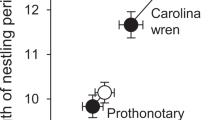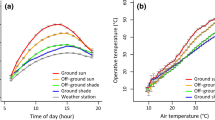Abstract
During hot weather, terrestrial animals often seek shaded thermal refugia. However, this can result in missed foraging opportunities, loss of body condition and impaired parental care. We investigated whether such costs could compromise breeding success in a widespread southern African bird: the Southern Yellow-Billed Hornbill Tockus leucomelas. We predicted that hornbills might be especially vulnerable to temperature-dependant reductions in parents’ foraging capacity due to extreme asymmetry in sex-specific roles during breeding: females are confined within the nest cavity for most of the nesting period and the burden of provisioning falls solely on the male during this time. We followed 50 hornbill nesting attempts in the Kalahari Desert between 2012 and 2015, collecting data on provisioning rates, adult and nestling body mass, fledging success and size of fledglings. Mean daily maximum air temperatures (Tmax) during nesting attempts ranged from 33.2 to 39.1 °C. The likelihood of successful fledging fell below 50% at mean Tmax > 35.1 °C; a threshold now regularly exceeded at our study site due to recent climate warming. Additionally, offspring fledging following the hottest nesting attempts were > 50% lighter than those fledging following the coolest. Sublethal costs of keeping cool including loss of body condition, production of poor-quality offspring and breeding failure are likely to become issues of serious conservation concern as climate change progresses; even for currently widespread species. Missed-opportunity costs associated with behavioral thermoregulation and direct sublethal costs of temperature exposure should not be overlooked as a potential threat to populations, especially in environments that are already hot.




Similar content being viewed by others

Data availability
The datasets generated during and/or analysed during the current study are available in the University of Cape Town ZivaHub repository: https://doi.org/10.25375/uct.12063591.v1
References
AlRashidi M, Kosztolányi A, Küpper C et al (2010) The influence of a hot environment on parental cooperation of a ground-nesting shorebird, the Kentish plover Charadrius alexandrinus. Front Zool 7:1
Angilletta MJ, Cooper BS, Schuler MS, Boyles JG (2010) The evolution of thermal physiology in endotherms. Front Biosci E2:861–881
Ardia DR, Pérez JH, Clotfelter ED (2006) Nest box orientation affects internal temperature and nest site selection by Tree Swallows. J F Ornithol 77:339–344
Barton K (2010) MuMIn: multi-model inference. R package version 0.13.14
Bates D, Maechler M, Bolker B (2019) Linear mixed-effects models using “Eigen” and S4. R package version 1.1.21
BirdLife International (2016) Tockus leucomelas. The IUCN Red List of Threatened Species 2016: e.T22682384A92942849. https://doi.org/10.2305/IUCN.UK.2016-3.RLTS.T22682384A92942849.en. Accessed 11 Apr 2020
Braasch A, Schauroth C, Becker PH (2009) Post-fledging body mass as a determinant of subadult survival in Common Terns Sterna hirundo. J Ornithol 150:401–407
Butler MW, Whitman BA, Dufty AM (2009) Nest box temperature and hatching success of American kestrels varies with nest box orientation. Wilson J Ornithol 121:778–782
Carroll JM, Davis CA, Elmore RD et al (2015) Thermal patterns constrain diurnal behavior of a ground-dwelling bird. Ecosphere 6:1–15
Catry I, Catry T, Patto P et al (2015) Differential heat tolerance in nestlings suggests sympatric species may face different climate change risks. Clim Res 66:13–24
Clutton-Brock TH, Maccoll A, Chadwick P et al (1999) Reproduction and survival of suricates (Suricata suricatta) in the southern Kalahari. Afr J Ecol 37:69–80
Coe BH, Beck ML, Chin SY et al (2015) Local variation in weather conditions influences incubation behavior and temperature in a passerine bird. J Avian Biol 46:385–394
Conradie SR, Woodborne SM, Cunningham SJ, McKechnie AE (2019) Chronic, sublethal effects of high temperatures will cause severe declines in southern African arid-zone birds during the 21st century. Proc Natl Acad Sci USA 116:14065–14070
Crick HQP (1992) Load-lightening in cooperatively breeding birds and the cost of reproduction. Ibis 134:56–61
Cunningham SJ, Martin RO, Hojem CL, Hockey PAR (2013) Temperatures in excess of critical thresholds threaten nestling growth and survival in a rapidly-warming arid savanna: a study of common fiscals. PLoS ONE 8:e74613
du Plessis KL, Martin RO, Hockey PAR et al (2012) The costs of keeping cool in a warming world: Implications of high temperatures for foraging, thermoregulation and body condition of an arid-zone bird. Glob Chang Biol 18:3063–3070
Dunn PO, Winkler DW (1999) Climate change has affected the breeding date of tree swallows throughout North America. Proc R Soc B Biol Sci 266:2487–2490
Dunn PO, Winkler DW (2010) Effects of climate change on timing of breeding and reproductive success in birds. In: Moller AP, Fiedler W, Berthold P (eds) Effects of climate change on birds. Oxford University Press, Oxford, pp 113–126
Dybala KE, Eadie JM, Gardali T et al (2013) Projecting demographic responses to climate change: adult and juvenile survival respond differently to direct and indirect effects of weather in a passerine population. Glob Chang Biol 19:2688–2697
Engelbrecht F, Adegoke J, Bopape M-J et al (2015) Projections of rapidly rising surface temperatures over Africa under low mitigation. Environ Res Lett 10:85004
Green DJ, Cockburn A (2001) Post-fledging care, philopatry and recruitment in brown thornbills. J Anim Ecol 70:505–514
Greño JL, Belda EJ, Barba E (2008) Influence of temperatures during the nestling period on post-fledging survival of great tit Parus major in a Mediterranean habitat. J Avian Biol 39:41–49
Hochachka PW, Somero GN (1984) Biochemical adaptation. Princeton University Press, Princeton
Iknayan KJ, Beissinger SR (2018) Collapse of a desert bird community over the past century driven by climate change. Proc Natl Acad Sci USA 115:8597–8602
James D, Bachan A, Kannan R (2011) Installation of artificial nest cavities for the endangered great hornbill: a pilot study in southern India. Raffles Bull Zool 24:73–76
Kearney M, Shine R, Porter WP (2009) The potential for behavioral thermoregulation to buffer “cold-blooded” animals against climate warming. Proc Natl Acad Sci USA 106:3835–3840
Kemp AC (1995) The hornbills: bucerotiformes. Oxford University Press, Oxford
Kruger AC, Sekele SS (2012) Trends in extreme temperature indices in South Africa: 1962–2009. Int J Climatol 33:661–676
Lefcheck JS (2016) piecewiseSEM: piecewise structural equation modelling in R for ecology, evolution, and systematics. Methods Ecol Evol 7:573–579
Lefcheck J, Byrnes J, Grace J (2018) PiecewiseSEM: piecewise structural equation modeling. R package version 2.0.2
McCarty JP, Winkler DW (1999) Relative importance of environmental variables in determining the growth of nestling tree swallows Tachycineta bicolor. Ibis 141:286–296
Metcalfe NB, Monaghan P (2001) Compensation for a bad start: grow now, pay later? Trends Ecol Evol 16:254–260
Moreau RE (1937) The comparative breeding biology of the African hornbills (Bucerotidæ). Proc Zool Soc Lond 107A:331–346
Moreau RE, Moreau WM (1941) Breeding biology of silvery-cheeked hornbill. Auk 58:13–27
Oswald SA, Bearhop S, Furness RW et al (2008) Heat stress in a high-latitude seabird: effects of temperature and food supply on bathing and nest attendance of great skuas Catharacta skua. J Avian Biol 39:163–169
Paniw M, Maag N, Cozzi G et al (2019) Life history responses of meerkats to seasonal changes in extreme environments. Science 363:631–635
Pasuwan C, Pattanakiat S, Navanugraha C et al (2011) An assessment on artificial nest construction for hornbills in Budo Sungai Padi National Park, Thailand. Raffles Bull Zool 24:85–93
Pinheiro J, Bates D, DebRoy S et al (2019) nlme: linear and nonlinier mixed effects models. R package version 3.1-137
Reid JM, Monaghan P, Ruxton GD (2000) Resource allocation between reproductive phases: the importance of thermal conditions in determining the cost of incubation. Proc R Soc B Biol Sci 267:37–41
Rosseel Y, Jorgensen T, Oberski D, et al (2018) lavaan: latant variable analysis. R package version 0.6.3
RStudio Team (2015) RStudio: Integrated Development for R. RStudio, Inc., Boston, MA. http://www.rstudio.com/
Salaberria C, Celis P, López-Rull I, Gil D (2014) Effects of temperature and nest heat exposure on nestling growth, dehydration and survival in a Mediterranean hole-nesting passerine. Ibis 156:265–275
Sears MW, Raskin E, Angilletta MJ (2011) The world is not flat: defining relevant thermal landscapes in the context of climate change. Integr Comp Biol 51:666–675
Sinervo B, Méndez-de-la-Cruz F, Miles DB et al (2010) Erosion of lizard diversity by climate change and altered thermal niches. Science 328:894–899
Skaug H, Fourmier D, Nielson A et al (2016) glmmADMB: generalized linear mixed models using AD Model Builder. R package version 0.8.3.3
Stanback M, Richardson DS, Boix-Hinzen C, Mendelsohn J (2002) Genetic monogamy in Monteiro’s hornbill, Tockus monteiri. Anim Behav 63:787–793
Tieleman BI, Noordwijk HJVAN, Williams JB (2008) Nest site selection in a hot desert: trade-off between microclimate and predation risk? Condor 110:116–124
van de Ven TMFN, McKechnie AE, Cunningham SJ (2019) The costs of keeping cool: behavioural trade-offs between foraging and thermoregulation are associated with significant mass losses in an arid-zone bird. Oecologia 191:205–215
van de Ven TMFN, Fuller A, Clutton-Brock TH (2020) Effects of climate change on pup growth and survival in a cooperative mammal, the meerkat. Func Ecol 34:194–202
van Wilgen NJ, Goodall V, Holness S et al (2016) Rising temperatures and changing rainfall patterns in South Africa’s national parks. Int J Climatol 36:706–721
Wiley EM, Ridley AR (2016) The effects of temperature on offspring provisioning in a cooperative breeder. Anim Behav 117:187–195
Woodroffe R, Groom R, Mcnutt JW (2017) Hot dogs: High ambient temperatures impact reproductive success in a tropical carnivore. J Anim Ecol 86:1329–1338
Acknowledgements
We thank the Kalahari Research Trust and the De Bruin and Kotze families for support and access provided to their land, and Lisa Nupen and Nicholas Pattinson for their assistance monitoring this population in the 2016/2017 and 2017/2018 field seasons.
Funding
This research was funded by the DSI-NRF Centre of Excellence at the FitzPatrick Institute. Any opinions, findings and conclusions or recommendations expressed in this material are those of the author(s) and do not necessarily reflect the views of the National Research Foundation.
Author information
Authors and Affiliations
Contributions
SJC, AEM and TMFNVDV conceived and designed the study. TMFNVDV collected data in the field. TMFNVDV, SJC and SE analyzed the data. SJC, TMFNVDV, and AEM jointly wrote the manuscript, with input from SE. All authors gave final approval for publication.
Corresponding author
Ethics declarations
Conflict of interest
The authors declare they have no conflict of interest.
Ethical standards
This research was conducted under ethical clearance from the Animal Ethics Committee, University of Cape Town (2012/V44/PH and 2013/V24/PR); and permits from the Northern Cape Department of Environment and Nature Conservation of South Africa (995/2012, 660/2013 and 1166/2013). All applicable institutional and/or national guidelines for the care and use of animals were followed.
Electronic supplementary material
Below is the link to the electronic supplementary material.
Rights and permissions
About this article
Cite this article
van de Ven, T.M.F.N., McKechnie, A.E., Er, S. et al. High temperatures are associated with substantial reductions in breeding success and offspring quality in an arid-zone bird. Oecologia 193, 225–235 (2020). https://doi.org/10.1007/s00442-020-04644-6
Received:
Accepted:
Published:
Issue Date:
DOI: https://doi.org/10.1007/s00442-020-04644-6



